SP AF 14mm F/2.8 Aspherical [IF] (Model 69E) - Tamron
SP AF 14mm F/2.8 Aspherical [IF] (Model 69E) - Tamron
SP AF 14mm F/2.8 Aspherical [IF] (Model 69E) - Tamron
Create successful ePaper yourself
Turn your PDF publications into a flip-book with our unique Google optimized e-Paper software.
INFRARED INDEX (Fig. 4)<br />
Special focus adjustment is required when using infrared black and white film with an<br />
infrared filter attached to the lens. Set the lens and the camera in manual focus mode and<br />
focus normally. Then adjust the focusing scale to the infrared index and attach the infrared<br />
filter to begin photographing. A critical focus may be obtained through test shooting(s).<br />
LENS HOOD<br />
A lens hood is built in as a part of this lens. In order to eliminate unnecessary and harmful<br />
stray light rays from outside the ultra-wide angle of view of the lens, the lens hood is built in<br />
as an inseparable part of the lens barrel. This built-in lens hood design also protects the<br />
front convex lens element, which has an extremely large curvature.<br />
CHECKING DEPTH OF FIELD (Refer to depth-of-field table)<br />
The depth-of-field table shows aperture values horizontally at top and ranges of focus vertically<br />
at left. If, for example, the aperture is set at f/4 and the distance to the subject is 1 m<br />
(3.3ft), the depth-of-focus value is 0.67 - 2.24m (2.2 - 7.39 ft.)as read in the table where f/4 in<br />
the horizontal column and 1m (3.3ft) in the vertical column intersect.<br />
* Refer to the instruction manual of your camera for additional information.<br />
* If your camera has a depth-of-field preview mechanism, the depth-of-field effect can<br />
be confirmed in the viewfinder. For further details on the preview mechanism, refer to the<br />
instruction manual of your camera.<br />
FILTER (Fig. 6)<br />
Due to the nature of this lens's ultra-wide angle of view, a filter cannot be attached to the<br />
front of the lens barrel. A sheet type of filter, such as a gelatin filter, may be cut using the<br />
template provided and inserted in the filter slot in the rear of the lens.<br />
* Cut and trim a sheet-type filter to the size of the template. If the template is not followed<br />
exactly, the filter may bend or, in some cases, snap out of position by the focusing movement<br />
of the lens and therefore may not work effectively.<br />
* Set the lens to the infinity position in order to insert or extract a filter from the filter slot of<br />
the lens.


![SP AF 14mm F/2.8 Aspherical [IF] (Model 69E) - Tamron](https://img.yumpu.com/27036192/7/500x640/sp-af-14mm-f-28-aspherical-if-model-69e-tamron.jpg)
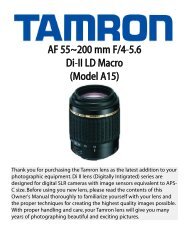

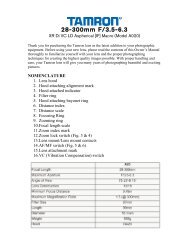
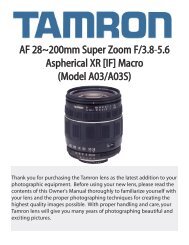
![SP AF 300mm F/2.8 LD [IF] for Canon (Model 360EE) - Tamron](https://img.yumpu.com/27036206/1/190x245/sp-af-300mm-f-28-ld-if-for-canon-model-360ee-tamron.jpg?quality=85)
![SP AF17-50mm F/2.8 XR Di LD Aspherical [IF] - Tamron](https://img.yumpu.com/27036204/1/190x245/sp-af17-50mm-f-28-xr-di-ld-aspherical-if-tamron.jpg?quality=85)
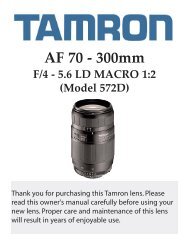
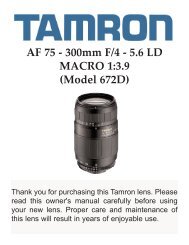
![AF 18~250 mm F/3.5-6.3 Di-II LD Aspherical [IF] - Tamron](https://img.yumpu.com/27036201/1/190x245/af-18250-mm-f-35-63-di-ii-ld-aspherical-if-tamron.jpg?quality=85)
![AF28-300mm F/3.5-6.3 XR Di LD Aspherical [IF] Macro ... - Tamron](https://img.yumpu.com/27036194/1/190x245/af28-300mm-f-35-63-xr-di-ld-aspherical-if-macro-tamron.jpg?quality=85)

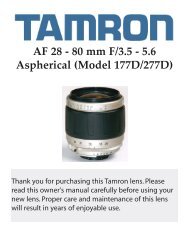
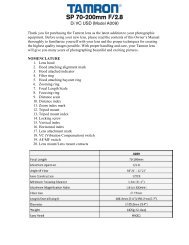
![SP AF 17~50 mm F/2.8 XR Di-II LD Aspherical [IF] (Model ... - Tamron](https://img.yumpu.com/27036181/1/190x245/sp-af-1750-mm-f-28-xr-di-ii-ld-aspherical-if-model-tamron.jpg?quality=85)